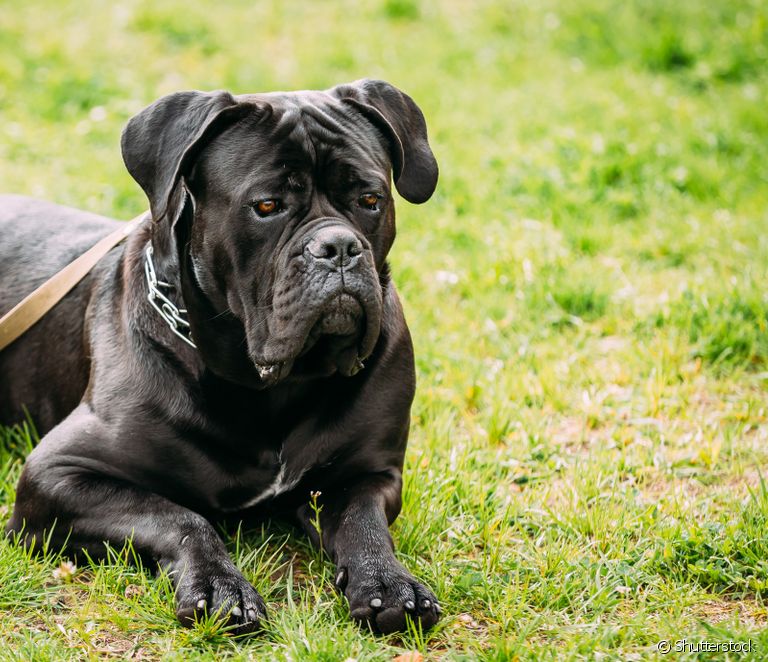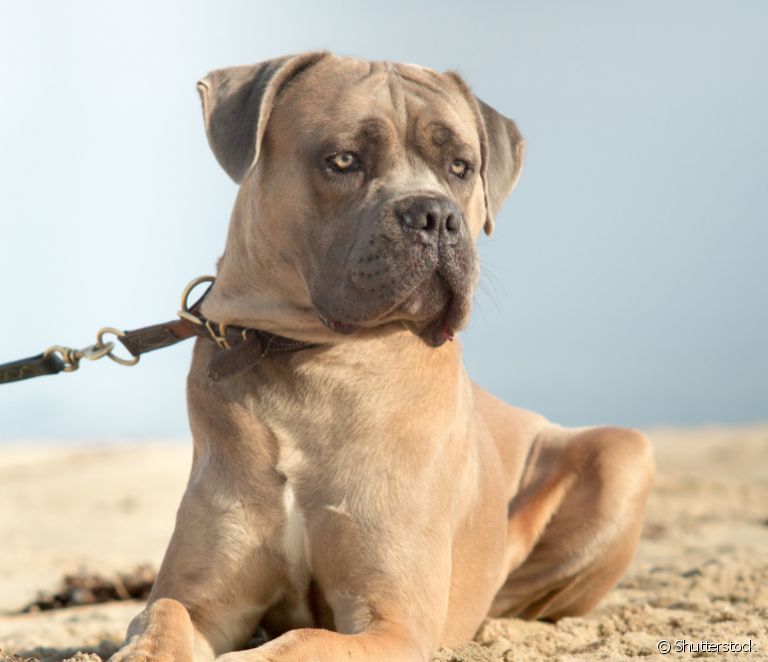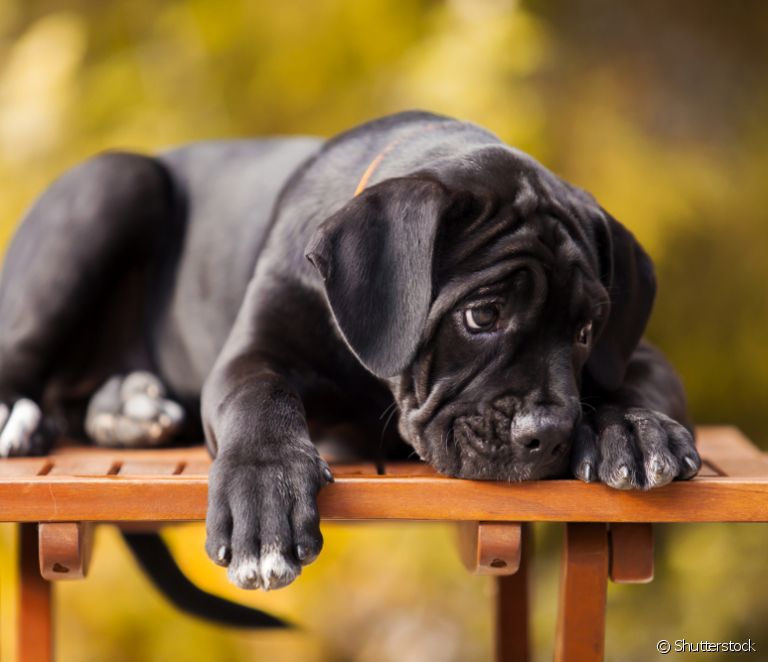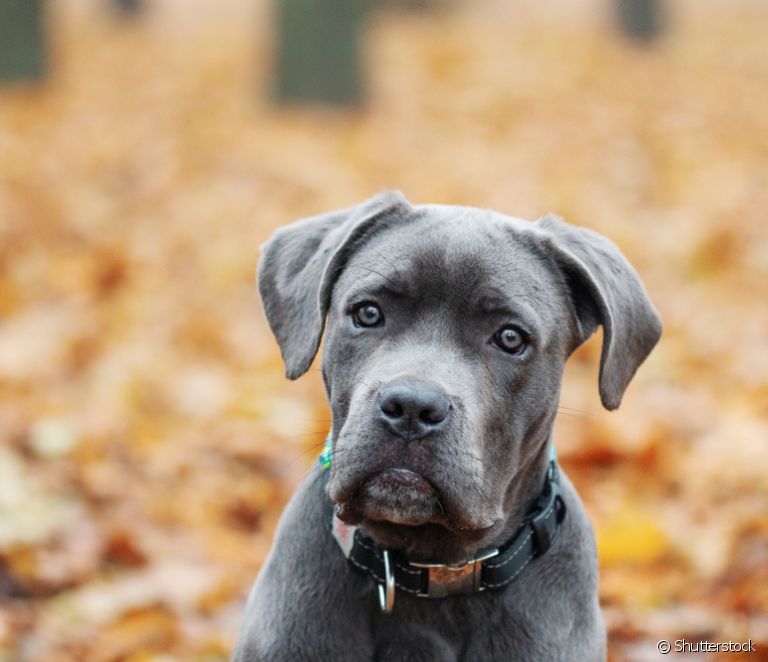Cane Corso: everything you need to know about the giant dog breed of Italian origin

Table of contents
Only those who have lived with a Cane Corso know how amazing this little dog is. Although not as popular as other large breeds, such as the Labrador and the Golden Retriever, the Cane Corso dog has a huge heart and an incredible personality. Some people may be intimidated by his size and imposing posture, but the giant Cane Corso is a great companion and only those wholiving with your pet knows how adorable and affectionate they are.
If you still don't know this dog breed, you don't have to worry anymore. We have prepared a guide with everything you need to know about the Cane Corso: physical characteristics, temperament, care and even how much a Cane Corso costs. See below and fall in love with this big dog!
Cane Corso: origin and history of the breed
The Cane Corso (or Cani Corso, as it is also called) is a breed that originated in Italy. It shares a common ancestor with the Neapolitan Mastiff: the Canix Pugnax, which was one of the most popular dogs during the period of the Roman Empire, but which has now become extinct. Because of this, the Cane Corso Italiano and the Mastiff have some similarities in common and many people may confuse them.
Just like its ancestor, the Cane Corso breed was created mainly to face territorial wars and fight possible invaders. It was on the side of the Roman army for a long time, and thanks to its history in battles, many people think that the Cane Corso is brave, but its behavior nowadays is far from being so.
See_also: Dog allergies: see the most common and how to treat themThe Cane Corso almost went extinct in Italy after the Second World War, but a few passionate breeders managed to save the breed. This is how it came to be known in several other places in the world. In 1996, the Cane Corso dog breed gained official recognition from the International Cynological Federation (FCI).
Cane Corso: size and main physical characteristics of the breed
To describe a Cane Corso, giant is the best word. As the adjective itself indicates, the dogs of the breed do not have a "standard" size, and always end up attracting attention for being much larger than other dogs. The adult Cane Corso can reach a height ranging from 60 cm to 68 cm, with a tolerance of 2 centimeters more or less; and weigh between 40 and 50 kg. In terms of appearance andsize, the Cane Corso is considered a rather muscular giant dog, robust and elegant at the same time.
Cane Corso: giant dog colors and hair appearance
The Cane Corso has a short, shiny, rough coat that does not require as much grooming as other breeds. For those who like variety and want to own a Cane Corso, multiple coat colors. The black Cane Corso is one of the most popular and most common to find out there, but it is also possible to find the following shades:
- Grey Cane Corso
- Red Cane Corso
- Brown Cane Corso
- Blue Cane Corso
- Brindle Cane Corso
Oh, and an important detail: there is no such thing as a white Cane Corso. Dogs with this shade are derived from crossing with other breeds, and therefore are not recognized by the official breed standard. Still on the coat, the Cane Corso has short, rough and hard hair that is easy to care for on a daily basis and does not require much attention.
Cane Corso: breed personality is docile but with a protective side
- Coexistence :
The idea that the Cane Corso is brave is just a mistaken impression. This dog is super docile, friendly and affectionate with those he loves; and is far from having an aggressive temperament. For the Cane Corso, family is very important and he quickly attaches himself to those who are part of his daily life, always showing all his loyalty and fidelity. It is no wonder that they tend to be super aggressive.protective of their guardians and do everything to protect them.
The problem is that often this protective instinct ends up showing more than it should, especially when visitors appear at home. Distrustful by nature, the Cane Corso is not so flexible when he has to deal with someone he does not know, but nothing that the socialization process does not solve.
In general, the Corso breed is very quiet. Despite being a giant and imposing dog, the Cane Corso does not bark much (unless strictly necessary) nor does it have destructive habits, but it needs a routine of intense physical activities to spend all its energy. Because it is very active, it is not a good idea to raise the dog inside apartments, unless you can walk with the dog.As he is very energetic and one of the most playful dog breeds, he needs physical activities lasting up to an hour. In addition, environmental enrichment is essential to keep up with his pace.
- Socialization :
As already mentioned, the Cane Corso dog breed does not get along very well with strangers, because they see them as a threat. As they were originally trained to defend territories, it is common for these dogs to adopt a vigilant and guarding posture to take care of the house. But of course it is also possible to turn it into a companion dog, making the Cane Corso more friendly and less "alert"For this to happen, socialization is indispensable and must occur as early as the first year of the animal's life, with the Cane Corso puppy.
The relationship of the dog with children, on the other hand, is very fruitful. The Cane Corso is pure love with the little ones, being very patient and tolerant. However, it is good to supervise the interactions between them. With other pets, the Cane Corso dog has a dominant and territorial behavior, so socialization is also necessary.
- Training :
Cane Corso dog training is essential to train his obedience. Being a dog that was originally used as a guard dog, the Cane Corso often tries to take charge of the situation and ends up following his instincts. He needs firm and patient leadership to learn that he is not the "master of the piece" and that he must obey certain rules. Positive training is the key to obedience.best way to educate the Cane Corso: dog breed should be rewarded with treats and praise whenever it is obedient and gets the commands right.
See some photos of Cane Corso to fall in love with!










5 curiosities about the Cane Corso
1) The arrival of the Cane Corso in Brazil is a very unusual story: presenter Fausto Silva fell in love with the breed after meeting it on a trip and requested some specimens for the country, which came directly from Rome.
2) Some people confuse the Cane Corso dog with a Pitbull. This happens because some dogs have their ears cut off, a practice prohibited in Brazil.
3) The Cane Corso is also known as the Italian Mastiff.
4) The Corso puppy can have litters of approximately 6 puppies.
5) Cane Corso dogs make the list of dog breeds with the strongest bite, reaching 700 PSI and coming in just behind the leader, the Kangal.
Cane Corso puppy: what to expect and how to take care of the puppy?
The Cane Corso puppy is gentle and affectionate. He may have a few spikes of energy as he develops, but that's natural for his age. Unlike other small or medium-sized dogs, giant dogs take longer to reach adulthood. So it's good to prepare yourself to deal with the Cane Corso puppy for at least two years - but don't forget that he'll soon become an adult.A good tip is to look for male and female dog names that reflect the grandeur and grandeur of the adult Cane Corso.
The Cane Corso puppy needs an age-specific and good quality food to grow healthy and strong. In addition, it is important to give all puppy vaccines and dewormers in the first months to ensure the pet's protection. Consult a veterinarian for more information!
Basic care routine for the Cane Corso
- Bath It is not necessary to bathe the Corso dog so often, unless it is very dirty. In general, a bath every three months is ideal.
- Brushing The Cane Corso has very short hairs that don't fall out often, so a weekly brushing is enough to remove dead hairs and keep the coat healthy.
- Nails The Cane Corso's claws can be painful and annoying, so it is recommended to cut the dog's nails at least once or twice a month.
- Teeth : Tartar is a very common problem among dogs, but it can be avoided with weekly tooth brushing. Two to three times a week is ideal.
- Ears Cleaning your dog's ears is important to avoid infections in the area, such as canine otitis. Always use veterinary products, which are suitable for pets.
What you need to know about Cane Corso dog health
When it comes to the Cane Corso, the dog is usually very strong and healthy. However, like other large breeds, it has a genetic predisposition to hip dysplasia and elbow dysplasia. In the first case, there is a wrong fit in the hip joints that results in constant friction and pain in the region, making it difficult for the patient to move. In elbow dysplasia,the Cane Corso suffers wear and tear of the cartilage and can also have its movements compromised.
Gastric torsion in dogs is another frequent concern, caused by rapid feeding. In addition, the tutor must pay attention to the amount of food offered to the Cane Corso dog, as any exaggeration can trigger a canine obesity condition. To avoid these and other health problems, veterinary check-ups are essential. Consultations serve to assess the health status of the breedCorso and are also a way to keep vaccinations and deworming up to date.
Cane Corso: life expectancy of the breed can reach 12 years
If you want to know how many years a dog lives, the answer will depend mainly on the care that each animal receives throughout its life, but it may also have to do with the breed. In the case of the Cane Corso, the average life expectancy is 10 to 12 years if it is a healthy dog with frequent physical and mental stimulation. Taking care of the well-being and quality of life of the animal is something that only depends on the dog's health.family!
Cane Corso: price of the breed can reach R $ 5 thousand
After learning a little more about this large dog breed, the question remains: how much does a Cane Corso puppy cost? The price will depend on a number of factors, such as the animal's lineage, sex and the colors of its hair. Females always tend to cost more than males, and dogs descended from champions also tend to be more expensive. But, in general, it is possible to find a Cane Corso puppy.Cane Corso puppy for prices between R$ 3 thousand and R$ 5 thousand.
However, before buying a specimen, it is important to take a very important care. When it comes to a breed dog like the Cane Corso, the kennel chosen must be reliable. The best way to guarantee this is to look for reviews from other customers to avoid pitfalls and any other problems. Another tip is to make a few visits to the place before making the purchase, so youcan make sure that they really are committed to the welfare of animals and do not mistreat them.
X-ray of the Cane Corso dog breed
Origin : Italy
Coat : short and rough
Colors : black, gray, red, brown, blue and brindle
Personality : protective, territorial, affectionate and loyal
See_also: Gastric torsion in dogs: what it is and how to identify itHeight : 60 to 68 cm
Weight : 40 to 50 kg
Life expectancy : 10 to 12 years

